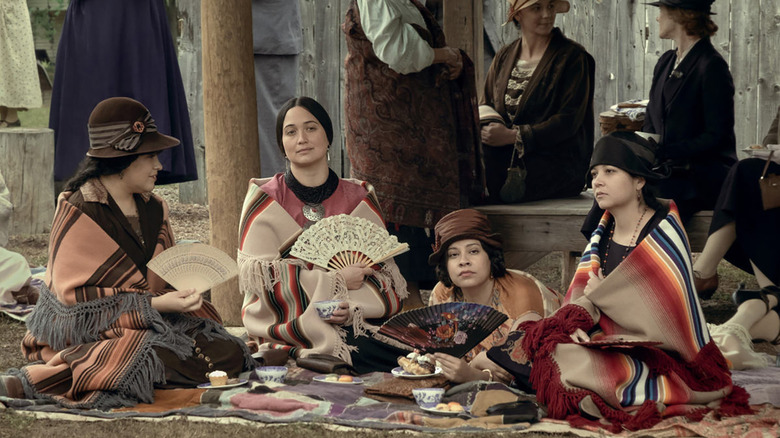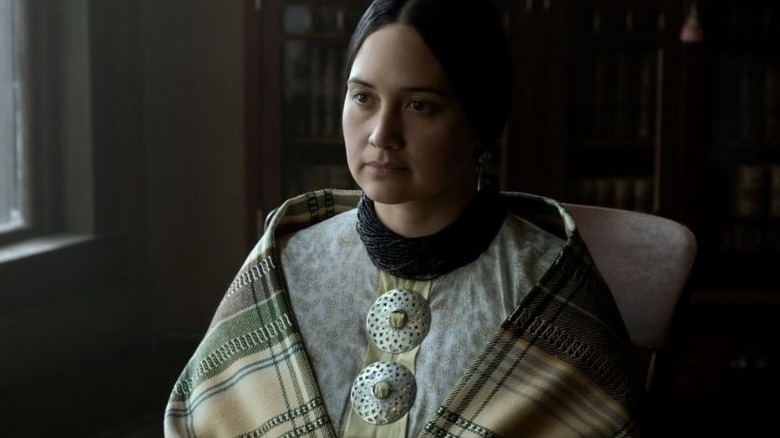Killers Of The Flower Moon's Title Is Key To Understanding The Film
This article contains spoilers for "Killers of the Flower Moon."
When you think of a Martin Scorsese movie, the titles are typically matter-of-fact. "Goodfellas" is about a group of, well, goodfellas. "Taxi Driver" is about, you guessed it, a taxi driver. "After Hours" takes place after hours, "Shutter Island" takes place on Shutter Island, and "The Aviator" is about an aviator. Even in instances where titles get a bit more metaphorical, say "The King of Comedy" or "The Wolf of Wall Street," the title is a tongue-in-cheek description of the film's protagonist. Scorsese's latest film is an adaptation of David Grann's book "Killers of the Flower Moon: The Osage Murders and the Birth of the FBI," and as such, takes its title from the source material. "Killers of the Flower Moon" is based on a historical atrocity committed against the Osage people in the 1920s, one that a majority of people who came through the American education system likely didn't know ever happened.
Originally from the Ohio and Mississippi river valleys, the Osage people had been pushed to Missouri and Kansas by white settlers, and eventually forced to relocate to what we now call Oklahoma as white colonists expanded West. The Osage retained communal mineral rights during the allotment process of the land, which paid handsomely when oil was found under the land. The Osage became the wealthiest people per capita in America, and as to be expected, entitled, racist white people wanted a piece of it, by any means necessary. Scorsese's film centers on the story of Mollie Kyle (Lily Gladstone), an Osage woman married to a white man Ernest Burkhart (Leonardo DiCaprio), who under the leadership of his uncle William Hale (Robert De Niro), personally carried out or was complicit in the murders of most of her family.
This makes the "killers" part of the title quite obvious, but what of the "flower moon?"
Thieves of love, life, and resources
David Grann explains the reasoning behind the title in the opening of his book, and Scorsese's film has it narrated by Mollie Kyle. Every April, millions of tiny flowers like Johnny-jump-ups, sprint beauties, and bluets blossom over the Osage land. In May, the same time of the year when coyotes (the nickname Mollie gives Ernest) howl beneath a large moon, taller plants like spiderworts and black-eyed Susans begin to grow. These plants overtake the smaller blooms, stealing their sunshine and rainwater. The small flowers try to reach for resources, but their necks break, their petals fall, and they are buried beneath the taller plants. The Osage refers to this time period as "the time of the flower-killing moon."
The story of the taller plants coming in and stealing the resources of the spring flowers, thus causing their deaths, is a metaphor for the way the powerful white men came in and brutally killed the Osage people for their own gains. The Osage had been dying mysteriously for a decade, but the start of William Hale's Reign of Terror, as it is now called, is landmarked with the murder of Mollie's sister Anna Brown, which took place in 1921. Osage poet, Elise Paschen, wrote about Anna's murder through the eyes of Mollie in the 2009 poem "Wi'-gi-e," which ends on a reference to the "Killers of the Flower Moon." The title is a beautiful albeit tragic reference to the real-life events that took place as described by the descendants of the community harmed. The white people who invaded the Osage killed them for their own selfish desires. They were no better than the flowers that continually overtake the vibrant blooms.
"Killers of the Flower Moon" is now playing in theaters.

